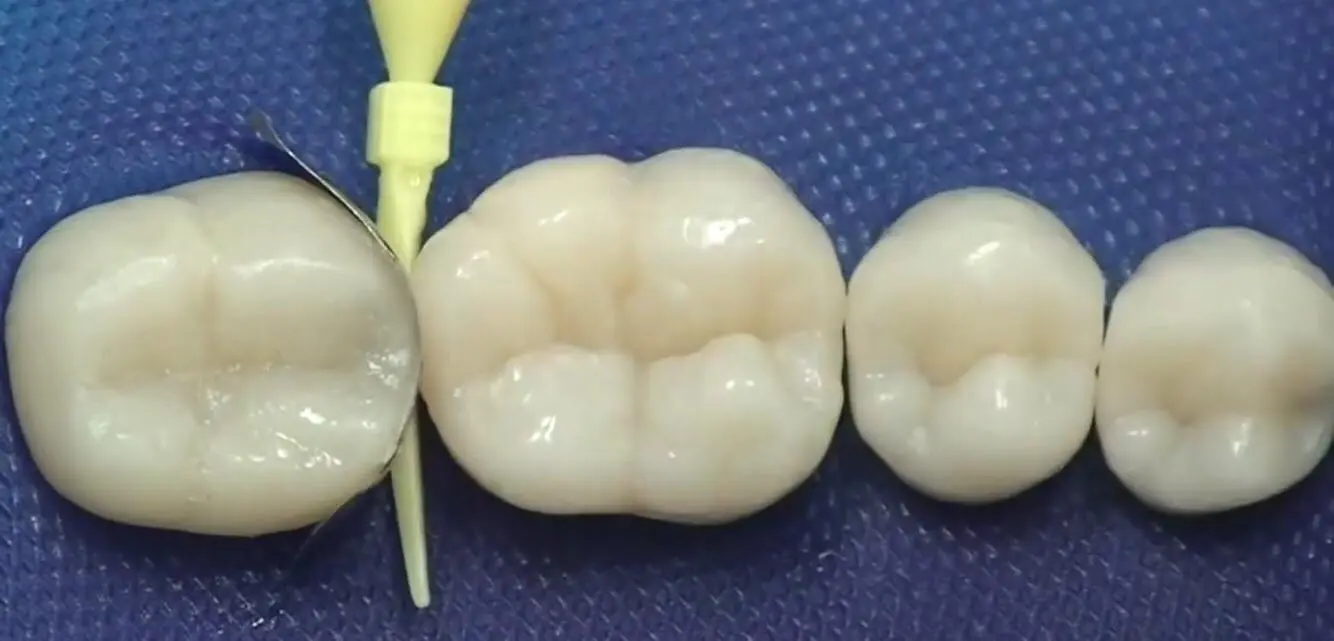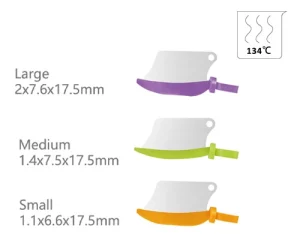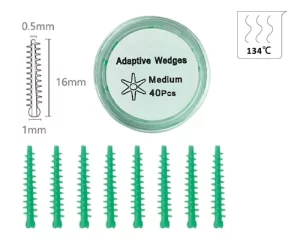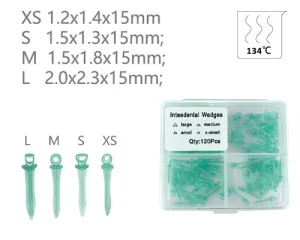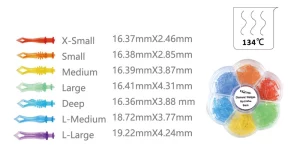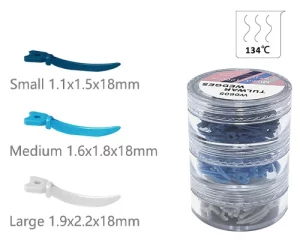على الرغم من أن صغيرة, تلعب أسافين الأسنان دورًا لا يمكن الاستغناء عنه في طب الأسنان التصالحي. يتم استخدامها بشكل أساسي لفصل الأسنان, استقرار عصابات المصفوفة وتشكيل حواف الترميم. اعتمادًا على المواد والتصميم, يختلف الأداء السريري واستخدام الأوتاد. في هذه المقالة, سنقوم بتحليل أنواع أنواع أسافين الأسنان, خصائص المواد, وظائفهم الرئيسية وتطبيقها في ملء واستعادة.
1. أنواع أسافين الأسنان وخصائص المواد
أسافين الأسنان البلاستيكية
مادة: في كثير من الأحيان مصنوعة من البولي بروبيلين الطبي (ص), مرن.
المزايا:
- المرونة المعتدلة تقلل من الضغط على اللثة.
- يمكن تعقيمها في درجات حرارة عالية وهي مناسبة لإعادة الاستخدام.
عيوب:
- دعم محدود, غير مناسب للحالات مع تسوس عميق أو فجوات ضيقة.
عرض عينة:
- حراس أسافين الأسنان (GD-5675): مع ثقب مع rblade
ثلاثة حجم: كبيرة/متوسطة/صغيرة

- الأوتاد التكيفية (GD-5677): مع النواة البلاستيكية الداخلية الثابتة, مغطاة بالسيليكون

- راتنج أسافين الأسنان (GD-5678): أربعة حجم, XS/S/M/L.

- أسافين الماس (GD-5679): سبعة حجم, X-Small/صغير/متوسط/كبير/عميق/لتر/L-large

- أسافين تولوار (GD-5680): ثلاثة حجم, صغيرة/متوسطة/كبيرة

أسافين الأسنان الخشبية
مادة: في الغالب بيرش أو الصنوبر, تعقيم. أسافين بيرش مع محتوى مائي 12% يمكن أن تتوسع إلى ما يصل إلى 18.7% في 30 دقائق في بيئة السوائل اللثة. هذه الخاصية التكيفية تجعلها مناسبة بشكل خاص لحالات ركود اللثة في المرضى القدامى. لكن, يجب توخي الحذر: قد يؤدي الإفراط في التوسع إلى ضغط مفرط على غشاء اللثة, مما يؤدي إلى حساسية ما بعد الجراحة.
المزايا:
- بطبيعة, أفضل مناسبة للفجوة أثناء العملية الجراحية.
- جامد, مناسبة لدعم القوة عالية من تجاويف من الدرجة الثانية.
عيوب:
- غير صالح للاستخدام, قد يسبب الإفراط في التوسع عدم الراحة.
عرض العينات:

أنواع أخرى
- إسفين معدني: نادر, شائع الاستخدام لإعداد التاج الكامل أو السيناريوهات التصالحية الخاصة.
- إسفين السيليكون: لينة ومرنة, مناسبة للترميم الجمالي, ولكن أكثر تكلفة.
2. الوظائف الأساسية الثلاثة لإسفين الأسنان
فصل الأسنان
- يفصل الأسنان المجاورة مؤقتًا 0.2-0.5 مم مع قوة ميكانيكية خفيفة لإنشاء مساحة تشغيل.
- هذا يمنع الاستعادة من التراجع ويعيد الشكل الطبيعي للنقاط المجاورة.
- أظهرت الدراسات السريرية أن الاستخدام السليم للأوتاد يمكن أن يقلل 60%.
تثبيت المصفوفة
- يمكن أن تساعد أسافين الأسنان في إصلاح قطعة القولبة, منع تسرب المادة التصالحية وتشكيل الكفاف المثالي.
- تجويف الثاني ترميم: الجمع مع عصابات المصفوفة الاستقرار هو الحل الكلاسيكي.
- ترميمات التجويف من الدرجة الخامسة: عادة مع لوحة صب منحنية.
Gum protection and hemostasis
- Dental wedges can provide a certain degree of protection above the gums.
- After the dental wedge is inserted into the tooth, it will exert a slight pressure on the gum, reducing bleeding during the operation.
3. Application Skills in Filling and Repair
كيفية اختيار الإسفين الأيمن
| معايير | نوع إسفين الموصى به |
|---|---|
| مساحة ضيقة interproximal | Wooden wedges, it’s expand and fit together after getting wet |
| الفضاء الواسع القريب | إسفين البلاستيك, elastic fit |
| راتنجات خفيفة | Clear plastic wedges, facilitate light penetration |
| ملء الملغم | Wooden wedges, it can offer stronger support |
Insert the Angle and direction
The dental wedge should be inserted obliquely into the interdental space from the lingual or buccal side of the tooth, and the Angle should be controlled at 30° to 45°. The core purpose of this Angle design is to avoid the gum tissue, prevent direct compression or scratching of the gum during vertical insertion, and reduce the risk of postoperative gum redness, swelling and bleeding.
Insertion depth control
The top of the wedge should be slightly higher than the edge of the restoration by approximately 0.5mm. This reserved space is designed to compensate for the shrinkage during the curing process of subsequent filling materials (مثل الراتنج), ensuring that the material can closely adhere to the edge of the tooth after curing and avoiding the formation of gaps that could lead to secondary caries.
Clinical precautions
Avoid excessive pressure on the gums: أثناء العملية, the insertion force of the dental wedge should be controlled. Excessive pressure can damage the attachment relationship between the gums and the teeth, which may cause postoperative gum recession. Clinical statistics show that the incidence of such complications is approximately 3% ل 7%.
Precise positioning of the insertion position: If the dental wedge is inserted at an offset position (such as being too close to the occlusal surface or the root tip direction), it may cause the contact points of adjacent teeth to be too loose, thereby affecting the stability of the normal occlusal relationship. Patients may experience problems such as weak bite and food impaction.
Actual case: Repair of deep wedge-shaped defect
Taking the repair of a deep wedge-shaped defect of the left lower first premolar as an example, the specific operation and therapeutic effect are as follows:
- Preoperative assessment: The patient was a 45-year-old adult. The cervical defect of the left lower first premolar had reached the deep dentin, accompanied by obvious cold and heat sensitivity symptoms. The Visual Analogue Scale (VAS) was used to assess the sensitivity degree, with a score of 6/10.
- Key operation techniques: أولاً, use the No. 00 gingival line for gingival drainage treatment. ثم, insert a pre-moistened pine wedge and let it stand for 15 minutes until it fully expands to widen the tooth gap. التالي, fluid resin is used as the base, and then 3M Z350XT resin is used for layered filling. The wedges should be retained until the resin has initially cured before being removed to prevent material deformation during the filling process.
- Postoperative efficacy: The patient was followed up for one year after the operation. The examination showed that the integrity rate of the restoration reached 98%, with no loosening, detachment or secondary caries. The patient’s cold and heat sensitivity symptoms completely disappeared, and the occlusal function returned to normal.
4. Purchasing Criteria for Dental Wedges
أولوية سلامة المواد
Core certification standards
The material and sterilization treatment of the wedge must comply with professional medical standards. Different materials correspond to clear certification requirements:
- Plastic wedges: Must have FDA (Food and Drug Administration of the United States) or CE (European Union Product Safety Certification) medical-grade polymer certification. The core needs to avoid harmful substances such as phthalates, which may migrate through contact and pose potential health risks. Compliance certification is the key basis for ensuring the safety of materials.
- Wooden wedges: A complete EO (ethylene oxide) sterilization report must be provided, and the report should clearly state that the biological load is ≤10⁻⁶ (أي., the probability of microbial survival after sterilization does not exceed one in a million), ensuring that there are no pathogenic bacteria remaining before use to avoid cross-infection or postoperative inflammation.
Key points to avoid pitfalls in procurement
عند الشراء, be cautious of non-medical grade products and especially reject “industrial wooden wedges” without any marking. Most of these products are made from leftover materials from industrial processing and have not undergone medical-grade treatment. They may contain harmful chemicals such as formaldehyde. When used, they not only easily irritate the gum tissue but may also be absorbed through the oral mucosa, posing a threat to the patient’s health. علاوة على ذلك, there are no unified standards for their size and hardness, which cannot meet the precise operation requirements of dental restoration.
Maximize the size fit rate
When choosing wedges, it is necessary to combine the actual clinical needs and maximize the size fit rate through “preoperative assessment + multi-specification reserve”.
Before the operation, the size of the required wedge should be initially determined based on the width of the interdental gap of the affected tooth (such as the interdental caries gap, wedge-shaped defect gap) and the tooth morphology (such as deciduous teeth and permanent teeth, normal teeth and inclined teeth).
It is recommended to stock up on multiple sizes of wedges (such as thin, واسطة, سميك, or thin and thick styles for special tooth gaps) to avoid poor fit due to insufficient single size, which may affect the gap opening effect or cause gum compression. This ensures that a matching model can be found for different cases, improving operational efficiency and restoration quality.
5. خاتمة
Although dental wedges are small in size and seem insignificant, they are indispensable “key supporting roles” in dental restoration operations. From material selection to standardized use, precise control over every link is not only the core guarantee for enhancing the stability of the restoration and reducing postoperative complications, but also can effectively improve the patient’s diagnosis and treatment experience and lay a foundation for a long-term good prognosis.

